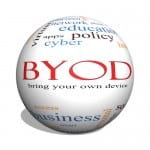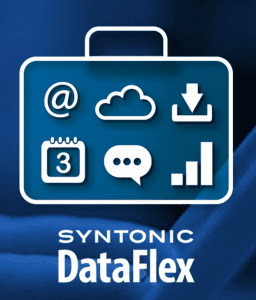 If, at the dawn of the modern computing era (and we are still in its infancy), someone had told you that one day you would be toting a personal, portable device that would allow you to perform many of the functions you handled at your workplace from virtually anywhere on the planet, you might have thought it pure fantasy.
If, at the dawn of the modern computing era (and we are still in its infancy), someone had told you that one day you would be toting a personal, portable device that would allow you to perform many of the functions you handled at your workplace from virtually anywhere on the planet, you might have thought it pure fantasy.
Today, the B.Y.O.D. (Bring Your Own Device) dream is alive, and the numbers are staggering. Estimates peg roughly 328 million employee-owned smartphone devices are now in use on the job.
As cloud-based access and mobility services expand, Gartner Group predicts that roughly 54% of employees are going to be required to use their own devices when and where they go to work as early as next year. So how can global business unleash the power of their employees’ mobile productivity by leveraging the BYOD movement and stay in compliance with state and federal law?
For Gary Greenbaum, CEO and cofounder of Syntonic such a disruptive shift in workplace paradigm was a lesson learned early in a storied career. After earning a PhD in physics at University of California, Greenbaum was headed for post-doc work on a Superconducting Super Collider In Waxahachie, Texas. It was there he learned from a U.S. Senator that the end of the Cold War also spelled the end of the SSC’s funding in favor of a NASA Space Station. Both he and his graduating class of physicists needed to find other work. Gary launched a company crunching algorithms instead of particles for IT-based video conferencing. The startup attracted and was acquired by one Rob Glaser and Greenbaum soon found himself creating RealVideo for RealNetworks.
 Later, at Microsoft, Greenbaum had an epiphany about the way the pendulum was swinging between enterprise and consumer technologies in terms of mobile productivity. “The mobile BYOD phenomenon had introduced huge cost inefficiencies that were not being addressed,” he explains. “After leaving Microsoft my co-founder, Rahul Agarwal, and I decided to focus on this enormous market.”
Later, at Microsoft, Greenbaum had an epiphany about the way the pendulum was swinging between enterprise and consumer technologies in terms of mobile productivity. “The mobile BYOD phenomenon had introduced huge cost inefficiencies that were not being addressed,” he explains. “After leaving Microsoft my co-founder, Rahul Agarwal, and I decided to focus on this enormous market.”
Seattle24x7: How would you describe the issues surrounding the BYOD economy?
Greenbaum: They are multi-fold. First, there’s a question about who is paying for the actual use of personally owned mobile devices that are brought to work by employees? BYOD is here to stay because employees are more productive—they can use their devices any place and anywhere, whether accessing their email or a particular app they use for work. Employees also enjoy that flexibility. But the question remains, who is paying for mobile data business use?
Right now there are a couple of options in the way businesses can manage BYOD reimbursement. They can pay nothing, which is a position that is rapidly becoming untenable because of legal rulings in states such as California mandating reimbursements for the business use of employee personal devices.
Alternately, companies can opt to pay flat reimbursements for the usage of their employees’ devices. The average today is around $70 dollars. However, this is not a fiscally responsible position because companies do not have actual data of what they are paying for in this case. In some cases employees are asked to submit expense reports for mobile data reimbursement: employees are equally unclear on how to calculate their reimbursement amounts.
Seattle24x7: How does Syntonic DataFlex meet these challenges?
Greenbaum: The principal functionality of the solution we call Syntonic DataFlex is to make it easy for companies to know exactly what percentage of their employees personal mobile devices are used for business, and to do so we provide “split billing.”
Through split billing, companies can pay the exact amount of mobile data usage on employee owned devices. We are providing app level analytics to enable businesses to do proper forecasting and budgeting, and ultimately providing insight about how to guide a company’s mobile investments for their employees.
Seattle24x7: Is there a particular type of employee who benefits most from BYOD?
Greenbaum: The reality is that not all employees are going to be using BYOD. For example Accounting, whose job might be to be on-premises in their chairs from 8-5; the mobility factor may not be as great. The way we designed Syntonic DataFlex is to enable IT and Finance to measure and provide financial allocation and budgeting down to the department and employee levels.
For instance, from an analytics standpoint, Syntonic DataFlex details how much the sales team is using their personal devices for business access to individual applications. We can drill down further and see how much a single employee uses.
Moreover, companies can use Syntonic DataFlex for provisioning applications, assigning people and departments the specific apps required by various roles. For example, remote access to a Salesforce.com app would be something a company can provide to the whole sales team, but it is unlikely that it would provide Salesforce to someone on the PR team. Syntonic DataFlex provides app level analytics.
 Seattle24x7: How does the system determine what qualifies as business use?
Seattle24x7: How does the system determine what qualifies as business use?
Greenbaum: Syntonic DataFlex features an online web console where IT provisions the particular applications employees need for their role. This same console also serves as an analytics dashboard and as a billing agent for processing invoices associated with data use.
The IT side does all the drag and drop app setup associated with the employees and or departments. Policies are applied to determine what applications the company is going to pay for based upon employee department and role.
On the employee side, our goal was to make the system frictionless. The Syntonic DataFlex application is installed on the employees device. It is currently available on Google Play and on the App Store. After downloading, the Employee simply logs in with their company credentials and the app transforms itself into the look and feel of the company brand as set up by IT, replete with the applications that have been assigned to a specific individual. The interface comes with the links to the applications that IT has deemed appropriate for a particular role.
An employee can choose to log into these apps through the Syntonic DataFlex app, or just click on the application that’s resident on the device without going through the Syntonic DataFlex applications. For instance, were I to download Salesforce from the app store, when I invoke it I’ll receive a notification that my company is paying for the usage of this application.
Seattle24x7: What are the technical underpinnings?
Greenbaum: Syntonic DataFlex installs a background service that separates the data traffic. If an application is has been associated with your role by IT, then that application’s traffic gets segmented to one of our backend proxies. If it is traffic for personal applications, it remains private and it’s sent through the normal network stack, not to the Syntonic DataFlex cloud service.
Seattle24x7: How do you separate voice and text?
Greenbaum: In today’s world voice and text are just apps. We recommend “Voice Over IP” (VOIP) applications, such as Skype. Company’s are embracing VOIP because it provides many benefits. If the employee leaves the company, taking their personal mobile device with them, the company still owns the VOIP phone number. The company can reallocate the phone number to another employee. Text messaging is also typically supported by these VOIP applications.
Syntonic DataFlex works with any app across the board — voice, data, text, websites and even custom apps: we can do the data segmentation on any device. For example, Wells Fargo has a whole suite of first party apps that they have developed for their employees that are not available in the app store, and that’s just fine for Syntonic DataFlex. We’re also not bound by the App stores for the delivery of these apps. As long as the custom applications are identifiable as apps, Syntonic DataFlex can separate the business application usage from personal usage.
Seattle24x7: How are reimbursements handled?
Greenbaum: We have two options for handling reimbursements. One option is enabling the mobile carriers, to generate two invoices—the employee receives their personal bill from the carrier for personal use on their mobile device and the carrier sends a separate bill to the business for the employee’s business application use. Syntonic DataFlex is operator independent as well and as a result can manage employee reimbursement by integrating with expense management systems or corporate payroll to reimburse employees in their biweekly paycheck for the mobile data that was used for business on their personal device.
So whether a company has an operator relationship or not, Syntonic DataFlex can support BYOD split billing.
Seattle24x7: What is happening in the legal and regulatory environment surrounding BYOD?
Greenbaum: There have been some interesting rulings. In one recent case, the Schwan’s Home Delivery Service in California, required employees to use their own personal devices but failed to reimburse employees for the usage. The court decided that the reimbursement was actually addressed under standing labor law that’s been in place for years, requiring businesses to reimburse employees for use of any personal assets.
What happens in California is not going to stay there. We believe that most of the 54% of companies today that are not paying employee reimbursements will likely be forced to pay in the near future. For those companies that are paying reimbursements, Syntonic DataFlex can save them money through accurate compensation and additional cost savings functionality.
As a result, we’ve been inundated by companies in a panic looking for a solution to the problem. Just yesterday, an insurance company in California, concerned about the implications of California labor law reached out to us about how to handle the reimbursements.
Seattle24x7: How are questions about privacy answered concerning the personal side of an employee-owned device?
Greenbaum: With Syntonic DataFlex companies do not have any access to any of an employee’s personal applications or data. We separate personal from business use and work within the balance of jurisprudence.
In continental Europe where companies are not allowed to erase ANY data on a personal device, we’re not seeing BYOD adoption. The situation is more of a company liable model where employees are given mobile devices to use for work rather than companies relying on employee’s personal devices. The UK however is following the same trend as the United States regarding BYOD and rapidly adopting BYOD because of the productivity and flexibility gains for business and employees. And if you look at the rest of the world, India or China or Brazil, roughly 80 percent of people in those countries work for companies using BYOD.
Seattle24x7: Are you up against competition in this market?
Greenbaum: If I were to segment the BYOD market between the larger enterprises and the small or medium-sized businesses, I would say categorically there is no one in the SMB space doing what we’re doing.
In the SMB space, you don’t have a need for the same level of IT sophistication or policies or security that you would have for enterprises.
There are almost 300,000 SMB’s with mobile workers in the United States, and it is a vastly underserved market. Our self-service portal makes it easy for IT to provision employees with applications.
In the enterprise space what we’re doing could be considered an adjacency to some other managed services. The nice thing is we have a first-to-market leadership position, not only in technology and marketing but in our working relationship with some of the operators.
Seattle24x7: How do companies sign up?
Greenbaum: We offer a free 30-day trial at Syntonic.com. Since it’s a self-service portal, any number of employees, from one to over 1,000, can participate. You can think of Syntonic DataFlex as an SaaS service for empowering mobile productivity.
Visit Syntonic at http://www.syntonic.com/




















